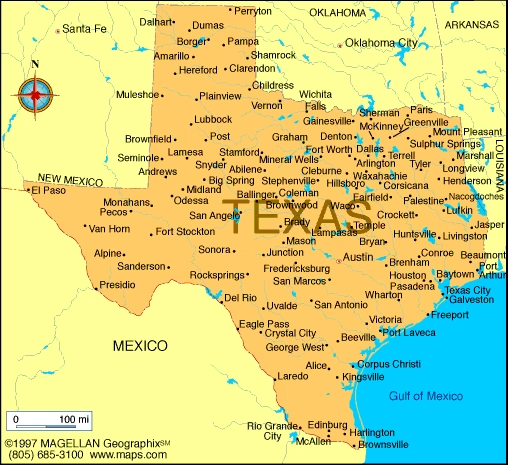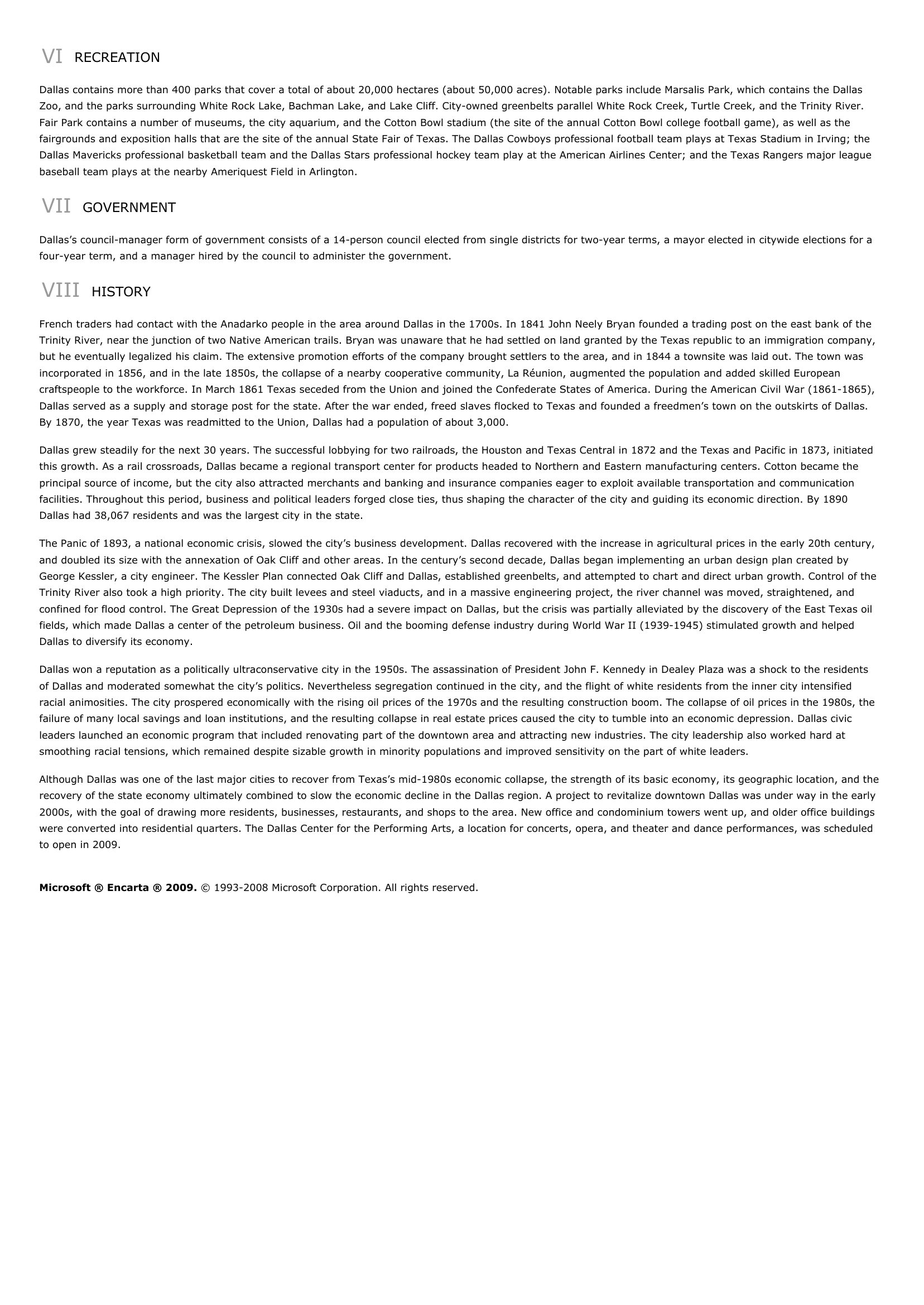Dallas (Texas) - geography.
Publié le 04/05/2013
Extrait du document


«
VI RECREATION
Dallas contains more than 400 parks that cover a total of about 20,000 hectares (about 50,000 acres).
Notable parks include Marsalis Park, which contains the DallasZoo, and the parks surrounding White Rock Lake, Bachman Lake, and Lake Cliff.
City-owned greenbelts parallel White Rock Creek, Turtle Creek, and the Trinity River.Fair Park contains a number of museums, the city aquarium, and the Cotton Bowl stadium (the site of the annual Cotton Bowl college football game), as well as thefairgrounds and exposition halls that are the site of the annual State Fair of Texas.
The Dallas Cowboys professional football team plays at Texas Stadium in Irving; theDallas Mavericks professional basketball team and the Dallas Stars professional hockey team play at the American Airlines Center; and the Texas Rangers major leaguebaseball team plays at the nearby Ameriquest Field in Arlington.
VII GOVERNMENT
Dallas’s council-manager form of government consists of a 14-person council elected from single districts for two-year terms, a mayor elected in citywide elections for afour-year term, and a manager hired by the council to administer the government.
VIII HISTORY
French traders had contact with the Anadarko people in the area around Dallas in the 1700s.
In 1841 John Neely Bryan founded a trading post on the east bank of theTrinity River, near the junction of two Native American trails.
Bryan was unaware that he had settled on land granted by the Texas republic to an immigration company,but he eventually legalized his claim.
The extensive promotion efforts of the company brought settlers to the area, and in 1844 a townsite was laid out.
The town wasincorporated in 1856, and in the late 1850s, the collapse of a nearby cooperative community, La Réunion, augmented the population and added skilled Europeancraftspeople to the workforce.
In March 1861 Texas seceded from the Union and joined the Confederate States of America.
During the American Civil War (1861-1865),Dallas served as a supply and storage post for the state.
After the war ended, freed slaves flocked to Texas and founded a freedmen’s town on the outskirts of Dallas.By 1870, the year Texas was readmitted to the Union, Dallas had a population of about 3,000.
Dallas grew steadily for the next 30 years.
The successful lobbying for two railroads, the Houston and Texas Central in 1872 and the Texas and Pacific in 1873, initiatedthis growth.
As a rail crossroads, Dallas became a regional transport center for products headed to Northern and Eastern manufacturing centers.
Cotton became theprincipal source of income, but the city also attracted merchants and banking and insurance companies eager to exploit available transportation and communicationfacilities.
Throughout this period, business and political leaders forged close ties, thus shaping the character of the city and guiding its economic direction.
By 1890Dallas had 38,067 residents and was the largest city in the state.
The Panic of 1893, a national economic crisis, slowed the city’s business development.
Dallas recovered with the increase in agricultural prices in the early 20th century,and doubled its size with the annexation of Oak Cliff and other areas.
In the century’s second decade, Dallas began implementing an urban design plan created byGeorge Kessler, a city engineer.
The Kessler Plan connected Oak Cliff and Dallas, established greenbelts, and attempted to chart and direct urban growth.
Control of theTrinity River also took a high priority.
The city built levees and steel viaducts, and in a massive engineering project, the river channel was moved, straightened, andconfined for flood control.
The Great Depression of the 1930s had a severe impact on Dallas, but the crisis was partially alleviated by the discovery of the East Texas oilfields, which made Dallas a center of the petroleum business.
Oil and the booming defense industry during World War II (1939-1945) stimulated growth and helpedDallas to diversify its economy.
Dallas won a reputation as a politically ultraconservative city in the 1950s.
The assassination of President John F.
Kennedy in Dealey Plaza was a shock to the residentsof Dallas and moderated somewhat the city’s politics.
Nevertheless segregation continued in the city, and the flight of white residents from the inner city intensifiedracial animosities.
The city prospered economically with the rising oil prices of the 1970s and the resulting construction boom.
The collapse of oil prices in the 1980s, thefailure of many local savings and loan institutions, and the resulting collapse in real estate prices caused the city to tumble into an economic depression.
Dallas civicleaders launched an economic program that included renovating part of the downtown area and attracting new industries.
The city leadership also worked hard atsmoothing racial tensions, which remained despite sizable growth in minority populations and improved sensitivity on the part of white leaders.
Although Dallas was one of the last major cities to recover from Texas’s mid-1980s economic collapse, the strength of its basic economy, its geographic location, and therecovery of the state economy ultimately combined to slow the economic decline in the Dallas region.
A project to revitalize downtown Dallas was under way in the early2000s, with the goal of drawing more residents, businesses, restaurants, and shops to the area.
New office and condominium towers went up, and older office buildingswere converted into residential quarters.
The Dallas Center for the Performing Arts, a location for concerts, opera, and theater and dance performances, was scheduledto open in 2009.
Microsoft ® Encarta ® 2009. © 1993-2008 Microsoft Corporation.
All rights reserved..
»
↓↓↓ APERÇU DU DOCUMENT ↓↓↓
Liens utiles
- Dallas (Texas) - geography.
- Texas - geography.
- San Antonio (city, Texas) - geography.
- San Antonio (city, Texas) - geography.
- Dallas 1 PRÉSENTATION Dallas, ville des États-Unis, au Texas.

































